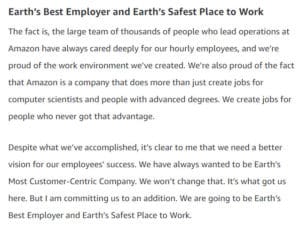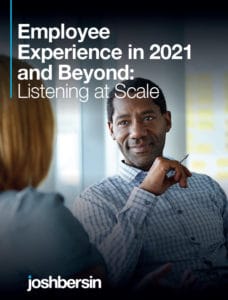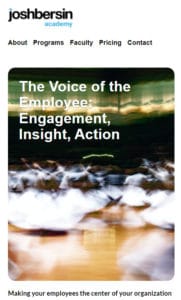Voice Of The Employee: The Most Important Topic In Business
Running a business can be a complex affair: you have to build products and services that customers want, you have to innovate to compete and stay relevant, and you have to manage sales, marketing, operations, and distribution. This is why there are so many business books and magazines: more than 2 million books per year try to teach you “the #1 thing” that will make you a better leader.
Well at the risk of sounding simplistic, I’d like to propose that one of the most important principles is listening to your employees. And the reason for this is simple:
Employees are the most “vested stakeholders” you have. Unlike customers (who can switch suppliers) or investors (who can sell their stock), employees vote with their lives to work for you. They put their family earnings, time, and personal energy into your company. So when they have problems or good ideas, you really have to listen.
Too often CEOs and other leaders look at employee listening as a “periodic engagement survey.” For decades we looked at employee listening as a “tool to improve retention.” So we built standard surveys, benchmarked results, and looked at this as an exercise in statistics. And while this is clearly a good idea, it doesn’t go far enough.
I’ve talked with dozens of companies about these survey programs, and they have all sorts of challenges. Early in my career, I interviewed the head of employee surveys for a global swiss bank, and he told me that after six months of survey analysis, they concluded that “district offices with strong career growth” had outperformed their peers. When I asked him “what are you going to do about it” he scratched his head and said “we decided to spend more money on L&D.” That particular bank, which will go unnamed, has since suffered more than $5 billion of fines and compliance violations. So I kind of think those surveys missed a few issues.
Here’s another funny example. A large tech company did an exhaustive employee survey to understand the productivity of working at home. They also spent six months doing A/B testing and analyzing lots of data, and eventually came to the conclusion that “there is no measurable difference” between people who work remotely vs. at home. What did they do about it? Nothing at all. The CEO just “likes walking around and seeing people in the office.”
And finally a third. A large utility had a major fire and explosion, killed several people, and wound up paying huge fines. In their post-mortem of the incident, they discovered emails and complaints from employees that pipelines and equipment were not being maintained. Employees were begging to spend money on reparis. The result? A massive business disruption that almost put the company out of business.
The point of these stories is not to criticize employee surveys: they’re important and useful in many ways. But the new world of engagement is one of “listening on many channels” and letting employees speak up, give suggestions, and contribute to every decision you make. And believe me, if you do this, your company will outperform your peers.
Employees are #1, Customers are #2
About five years ago I attended a user conference from one of the fastest-growing HR tech companies in the market. The CEO and Founder, a highly esteemed statesman, stood in front of 7,000 customers and made a simple speech. “I want you all to know that you are NOT my most important stakeholders. You are my SECOND most important. I think first about taking care of my employees because I know that they will take care of you.”
There was a massive round of applause.
 I had to chuckle to see that when Jeff Bezos from Amazon moved into the Chairman role, he suddenly decided that he wanted Amazon to be “the world’s best company for employees.” I wonder what caused him to have such a change of heart? Could it be the constant grilling by legislators? The Union threats? The high turnover and impossible challenge to hire? It was all of that – and I’m guessing a bit of a wake-up to the fact that the company he founded, one of the most valuable in the world, is no more than a huge collection of people. And this is why voice matters.
I had to chuckle to see that when Jeff Bezos from Amazon moved into the Chairman role, he suddenly decided that he wanted Amazon to be “the world’s best company for employees.” I wonder what caused him to have such a change of heart? Could it be the constant grilling by legislators? The Union threats? The high turnover and impossible challenge to hire? It was all of that – and I’m guessing a bit of a wake-up to the fact that the company he founded, one of the most valuable in the world, is no more than a huge collection of people. And this is why voice matters.
This week we launched a big Josh Bersin Academy program called Voice of the Employee, and it’s all about this topic. So let me give you a few insights to motivate you to join.
Five Big Issues To Consider
First and foremost, you have to make “employee listening” a cultural value.
Your company, regardless of its size, has to operate as a porous, listening-oriented management team. Every leader from the CEO to the first line supervisor should be encouraged to slow down and listen, create a place of psychological safety (where people can speak up), and take notes on what employees want.
Of course, we can never accommodate every employee’s needs. But when you “listen, hear, and react” to what employees say, you don’t only make better decisions but employees feel more engaged. Every study we just completed (our Pandemic Response Study, DEI Elevating Equity Study, and upcoming Employee Experience Study) shows that the quality and focus on listening are the most important practices for success.
Second, you have to open up multiple channels.
Surveys are great, and you can do lots of them easily. But you also have to conduct town hall meetings, team feedback sessions, post-mortem reviews, and lots of “suggestion boxes” where people can write their suggestions, recommend changes, and point out problems. IBM has global online “jams” that help the leaders redesign everything from pay practices to policies for work at home. You can do this too.
Microsoft, for example, surveys more than 2,500 employees every day, and makes sure people only get one survey per quarter – this data helps Dawn Klinghoffer, the head of People Analytics, immediately see issues in burnout, stress, work-life balance, and hundreds of other issues. The company is constantly redesigning work practices from this data.
Third, you have to connect feedback to action.
As I wrote about in the paper “Shortening The Distance From Signal to Action,” you can now buy survey and case management tools that immediately analyze employee feedback and send it to the manager, call center, or another department who can act. There’s no reason for an HR analyst to sit on the data for two months and analyze it. Let the platform do that automatically (tools like Perceptyx, Glint, Medallia, Peakon, Quantum Workplace, and Qualtrics do this).
 Fourth, you have to take a “product manager” approach to this information.
Fourth, you have to take a “product manager” approach to this information.
Every piece of data you get from employees should go into the “employee experience roadmap.” Companies like Astra Zeneca and Schneider Electric, for example, have EX “product teams” that look at all employee journeys in detail. They use survey data to improve the process all the time.
I think it’s particularly interesting that ServiceNow just added “listening posts” to its Employee Journey Management set of products. They understand that we have to make it easy for employees to say “this system kind of sucks” so the product owner can fix it.
One of our large Indian clients, a huge telco in Asia, actually has five-star ratings on every single micro-app they build for employees. You can bet the HR team immediately fixes things that get rated poorly.
Fifth, you have to analyze employee voice data holistically.
If you segment and analyze employee voice data you will discover amazing things. Bank of America found out, for example, that hiring people individually was far less effective than hiring people in cohorts. A large retailer found out that Black women were far less comfortable with managerial practices than other intersectionality groups. A large restaurant chain in Canada found out that service staff was spending too much time on drive-through service and they needed to redesign their cafes.
The opportunity to learn from employees is everywhere. And not only do different groups have different needs, they often bring suggestions you didn’t consider. A large Pharma company told me that their employee surveys pointed out how slow-moving and bureaucratic the “committee structure” was to decision making. The company used global “committees” for decades. During the pandemic, they canceled all the committees, and employees were immediately thrilled by their ability to get things done. The result? This long-held cultural belief in “committees” was debunked, and they did away with the whole process.
Remember that your company is really like a “society” in many ways. New joiners have a different experience than tenured experts. Line workers have different needs from office staff. And managers at different levels need different levels of support. Just like we have “local, state, and federal” government agencies to make our country responsive to citizens, you need similar “empowerment structures” to respond to employee needs.
This, by the way, is why HR Business Partners will never go away. No matter how good the data may be from the global “employee climate survey,” it’s what happens locally that matters. Your Employee Voice program has to reflect this.
 Employee Voice Drives Customer Success
Employee Voice Drives Customer Success
Let me close with one more thing. As the CEO above mentioned, employees are essentially a surrogate for your customers. When employees are upset or unhappy, you can bet your customers are too. In fact, one of the easiest ways to figure out why you’re losing customers is to get closer to your employees.
Hilton, a company that excels at employee and customer listening, surveys their location employees every day. These quick surveys are analyzed and compared to daily customer surveys (using Medallia), and the team can immediately see if a location has issues. If the cleaning staff has problems with the equipment, for example, they speak up and sure enough, it has a direct impact on customer netpromoter scores.
So don’t think about Employee Voice as an “HR thing.” This is a critical business process. Employee sentiment, feedback, and voice are not only important for hiring, retention, and engagement – they are a direct representation of your customer experience. In fact, one could argue that “employee experience” and “customer experience” are two sides of the same coin. You can’t push one without also pushing the other.
Please join us in our fantastic new program The Voice of the Employee in the Josh Bersin Academy. I guarantee you’ll learn a lot and you will have the opportunity to discuss this critical issue with thousands of other companies.
Additional Resources
Here are a few other resources to help you understand this topic. The first is a discussion of our Simply Irresistible model, which forms the basis of the new Employee Experience research coming out later this year.
Second, please read our research Listening at Scale, which details best practices for a scalable Employee Voice Program.
If you’d like to build your own Employee Voice program, please join our Corporate Membership program – it gives you access to all our research, advisory services, and the Josh Bersin Academy.
